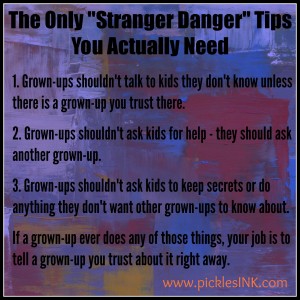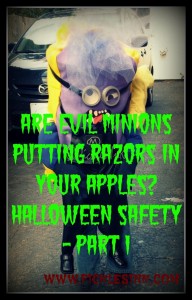We had a child luring attempt in our small town recently, which is of course terrifying. I haven’t done much talking to Ben and Molly so far about stranger danger, for a number of reasons.
Ben has a tendency to be very anxious. Last year one of his school friends told him about “strangers” and he went into an anxiety tailspin for days. Often once he starts thinking about something scary he’ll continue to worry about it no matter how remote or even completely impossible the threat is:
Ben: “I looked at that picture in my bug book and now I’m afraid of scorpions.”
Me: “There are no scorpions in Canada.”
Ben: “I know. But I’m still scared that one will sting me.”
Me: “But there aren’t any in Canada. You can’t be stung by one.”
Ben: “I know. But what if I was? They are extremely venomous.”
Me: “There is absolutely no way that you could be stung by a scorpion.”
Ben: “I know. But I’m still scared. What if I was?”
Me: “Well, you could pretend to be a giant bird that eats scorpions.”
Ben: “Okay! …Wait, now I’m scared of the giant bird.”
Me: *headdesk*
Statistics show that “stranger danger” is blown way out of proportion. The best and most recent estimate found that 25 children of the 46,718 reported missing in 2011 were listed as “abducted by stranger” — but “stranger” was defined as anyone who was not a parent, including relatives, family friends, or babysitters as well as the eponymous “stranger.” A 2003 study by the RCMP’s National Missing Children Services studied the 90 stranger abduction missing child reports entered into the national police database in 2000 and 2001 and found that only 2 of those children had been abducted by someone other than a relative or a close family friend.
Finally, up until last summer Ben wouldn’t have been anywhere unsupervised where a “stranger” could approach him anyway.
But my little baby boy is growing older, moving outside of my helicopter mommy bubble, spending time playing outside with friends, and even getting ready to walk to the bus stop by himself next year (all of which feels completely, utterly ridiculous to me before I remember that at his age I was walking 4 blocks to the corner store by myself).
So with this incident happening only blocks from our house, The Conversation became a necessity – obviously because the same person could still be in the neighbourhood, but also because I anticipated it being discussed at school (by both the teachers and the other kids), and I wanted Ben to hear it from me first so he could ask any questions he had and process the information thoroughly.
First of all – the reality. Stranger are not particularly dangerous. Most strangers are neutral to benign, and many can be quite helpful. You are far more likely to fall victim to a random act of kindness than a kidnapping attempt. The concept of “Stranger Danger” has actually served to distract 3 generations from the statistically greater danger to children – family members, friends, and acquaintances, who are far more likely to abuse, molest, and/or kidnap them than some creepy dude in a van.
Last month’s Today’s Parent Debate was about whether or not you would leave your child alone in the car, and the Facebook post on the topic garnered heated debate.
Much of the “no” side focused on the dangers of leaving your child unattended in a car – and there are certainly dangers to doing so – but a number of the posters were adamant that there was a significant risk that someone walking by would see your children and seize the opportunity to smash a window, get in, “hotwire” the car, and drive away with your children still buckled into their carseats like a beautifully wrapped present.
Scary, sure. Realistic? No. Pedophiles don’t walk around convenience stores and gas stations rubbing their palms together and waiting for an unattended car full of children. Pedophiles befriend their neighbours’ kids. They pay extra-special attention to their nieces. They take vacations to countries where child sex trafficking is rampant. They win the “Coach of the Year Awards”. They insinuate themselves into positions of trust and authority over children, ingratiate themselves to the parents, groom the children for years before they actually start abusing them, and cultivate an atmosphere of secrecy where the children don’t realize anything is wrong until it’s too late and they know that no-one would believe them anyway.
If you want your children to be safe from the boogeymen, you have to teach them what the boogeymen really are. The boogeymen are people who make your children feel uncomfortable. They are grownups who ask children for help and tell children to keep secrets. They could be people you love very much and whom your children love very much, people your child trusts and looks up to, and people you would never dream would do “something like that.”
I therefore decided that rather than focus on “strangers” or “bad guys” I would talk to Ben about “grown-ups,” and what grown-ups should and shouldn’t do when it comes to kids.
So this is what I told Ben:
“Bud, I need to talk to you about something a little bit scary. Remember when your friend told you about strangers, and made you scared about them, and I said that you didn’t need to worry about it? I need to talk to you a little more about strangers now. You know that strangers are just people you haven’t met yet, right? Most – almost all – strangers are not scary at all.
Sometimes people will tell you “never talk to strangers” but that’s not right. If you every get separated from mommy or daddy, you DEFINITELY need to talk to a stranger – good strangers to talk to are people wearing a uniform, or people who work in a store, or a mommy or daddy with kids. Those are all people who will know exactly how to help a lost child get back to his parents. And if you’re with mommy or daddy and a stranger talks to you, it’s polite to answer them, but you don’t have to have a long talk with them if you don’t want to.
Something happened this week in our town – a boy was walking home from school by himself, and a stranger stopped his car and talked to him and asked him to get into his car. That’s not okay. Grown-ups should not talk to kids who are by themselves, and they should definitely not ask kids to come with them.
That doesn’t happen very often at all, and it will probably never, ever happen to you, but just in case it ever does, it’s important to know what to do. This boy stayed safe because he knew exactly what to do – he didn’t answer the stranger and he ran away as fast as he could to a place with lots of people – back to his school – and he told a grown-up there. If a stranger ever talks to you or your friends when you aren’t with a grown-up, you don’t have to be polite. You and your friends run as fast as you can to a place where there are other people and tell a grown-up what happened.
Grown-ups should not talk to kids they don’t know unless there is another grown-up there to make the kids feel safe. Grown-ups should not ask kids for help with anything – they should ask other grown-ups. And grown-ups should not ask kids to keep secrets (surprises are different because they are not going to be kept secrets forever – only until it’s time for the surprise) or to do anything that another grown-up can’t know about.
If a grown-up ever does any of those things, your job is to tell a grown-up that you trust about it right away.”

Text reads: “The Only “Stranger Danger” Tips You Actually Need” 1. Grown-ups shouldn’t talk to kids they don’t know unless there is a grown-up you trust there. 2. Grown-ups shouldn’t ask kids for help – they should ask another grown-up. 3. Grown-ups shouldn’t ask kids to keep secrets or do anything they don’t want other grown-ups to know about. If a grown-up ever does any of those things, your job is to tell a grown-up you trust about it right away.
Molly listened too, and nodded sagely, though I don’t know how much of the conversation she took in. I was happy with the outcome as Ben asked questions, gave me the right answers when I quizzed him, and most importantly felt confident and not frightened when we finished the discussion.
~ karyn
What age did you start talking about “stranger danger” and “street smarts”? What do you think are the most important points to cover with your kids?


